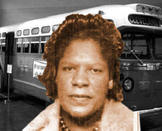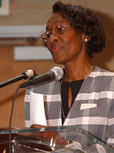|
There is so much more to be learned and shared about these powerful, trailblazing women. Their contributions to the civil rights movement have for the most part gone unnoticed.
Sometimes decisions are made that have a pivotal effect on the direction of a movement and changes the course of history. These decisions should be debated but they should not be criticized. Unless we were there at the time we have no insight into how things really were and what was necessary at that time to start a movement. Rosa Parks was not the first person to sit in the white section of a bus in Montgomery, Alabama. She was not the second person either. Rosa Parks was the sixth person and was chosen to represent the movement because she "fit the mode". The NAACP wanted to put a face to the Montgomery bus boycott that people could identify with. This article is not meant to demean or devalue the efforts of Rosa Parks or the decision to use her as the face of the boycott. This article is to acknowledge and celebrate the women who paved the way for the boycott to happen. Claudette Colvin Claudette Colvin Claudette Colvin Claudette Colvin was born on September 5, 1939. On March 2, 1955, at the age of 15, she was the first person arrested for resisting bus segregation in Montgomery, Alabama, preceding the better known Rosa Parks incident by nine months. Raised by her great-aunt and uncle, Colvin grew up in the King Hill, Montgomery. King Hill by far was not the affluent section for blacks. It wasn't even considered to be middle class. During an interview in 2000 she remarked: "Middle-class blacks looked down on King Hill," says Colvin today. "We had unpaved streets and outside toilets. We used to have a lot of juke joints up there, and maybe men would drink too much and get into a fight. It wasn't a bad area, but it had a reputation." Colvin was a good student. She earned mostly A's in her classes and even aspired to become president one day. Upon being told to give up her seat she refused. "It's my constitutional right to sit here as much as that lady. I paid my fare, it's my constitutional right." Colvin felt compelled to stand her ground. "I felt like Sojourner Truth was pushing down on one shoulder and Harriet Tubman was pushing down on the other—saying, 'Sit down girl!' I was glued to my seat," she later told Newsweek. Colvin, along with Mary Louise Smith, Aurelia Browder, Susie McDonald, and Jeanette Reese were the five women originally included in the federal court case, filed on February 1, 1956 as Browder v. Gayle (1956), and testified before the three-judge panel that heard the case in the United States District Court (Jeanette Reese withdrew from the case due to intimidation from white community). On June 13, 1956, the judges determined that the state and local laws requiring bus segregation in Alabama were unconstitutional. The case went to the United States Supreme Court, which upheld their ruling on December 17, 1956. Three days later, the Supreme Court issued an order to Montgomery and the state to end bus segregation in Alabama. Aurelia Browder Aurelia Browder Aurelia Browder Aurelia Shines Browder Coleman was born on January 29, 1919. In April 1955, months before the historic arrest of Rosa Parks, she was arrested for refusing to give up her bus seat to a white rider. She was listed as the lead plaintiff in the Browder v. Gayle (1956) lawsuit. At the time of the lawsuit, Browder was a housewife. She had several careers throughout her life, including working as a nurse, midwife, seamstress, and businesswoman. She earned a bachelor's degree in science with honors from Alabama State University. Browder was affiliated with several civil rights groups, including the National Association for the Advancement of Colored People (NAACP), the Montgomery Improvement Association, and the Southern Christian Leadership Conference (SCLC). Mary Louise Smith
Susie McDonald |
EditorErnest R. Heyward is the Founder and President of the Marketplace for Social Awareness and Social Responsibility Inc. Categories
All
Archives
June 2020
|
MARKETPLACE FOR SOCIAL AWARENESS AND SOCIAL RESPONSIBILITY INC.






